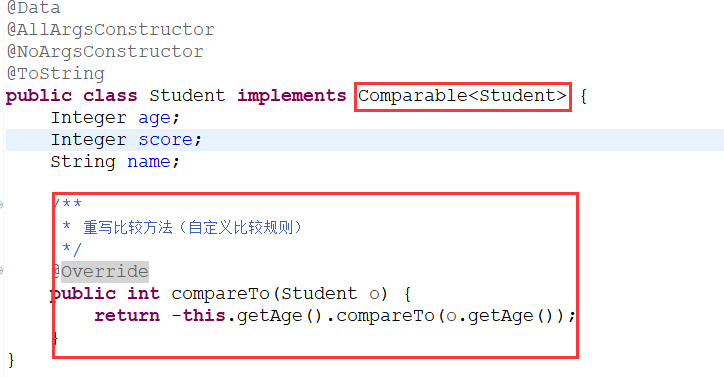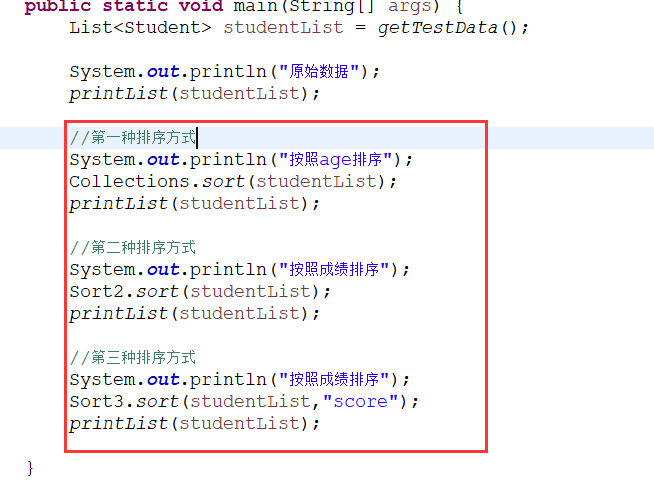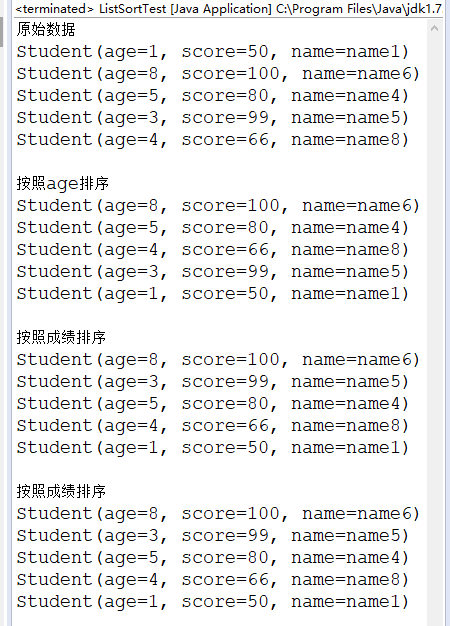(1)在元素的model定义的时候实现Comparable接口,重写compareTo方法,实现需要的比较方式。
关键代码:

完整代码

package com.songyan.demo.collection.list.sort;
import lombok.AllArgsConstructor;
import lombok.Data;
import lombok.NoArgsConstructor;
import lombok.ToString;
/**
* @author songyan
* @date 2020年5月21日 下午4:28:28
* @desc 学生类(在定义model类的时候定义比较规则)
*/
@Data
@AllArgsConstructor
@NoArgsConstructor
@ToString
public class Student implements Comparable<Student> {
Integer age;
Integer score;
String name;
/**
* 重写比较方法(自定义比较规则)
*/
@Override
public int compareTo(Student o) {
return -this.getAge().compareTo(o.getAge());
}
}
(2)在比较的时候指定比较的方式
关键代码:

完整代码:

package com.songyan.demo.collection.list.sort;
import java.util.Collections;
import java.util.Comparator;
import java.util.List;
/**
* @author songyan
* @date 2020年5月21日 下午4:31:40
* @desc 在比较的时候定义比较规则
*/
public class Sort2 {
public static void sort(List<Student> studentList) {
Collections.sort(studentList, new Comparator<Student>() {
@Override
public int compare(Student o1, Student o2) {
return -o1.getScore().compareTo(o2.getScore());
}
});
}
}
(3)基于反射可以对列表使用元素的任意属性排序
关键代码:

完整代码:

package com.songyan.demo.collection.list.sort;
import java.lang.reflect.InvocationTargetException;
import java.lang.reflect.Method;
import java.math.BigDecimal;
import java.util.Collections;
import java.util.Comparator;
import java.util.Date;
import java.util.List;
/**
* @author songyan
* @date 2020年5月21日 下午4:33:10
* @desc 基于反射实现对一个列表的任意字段的排序
*/
public class Sort3 {
/**
* 对"指定的集合"根据"指定的字段"排序
*
* @param list
* @param field
*/
public static <T> void sort(List<T> list, String field) {
if (list == null || list.size() == 0) {
return;
} else {
final String fieldName = getFieldName(field);
Collections.sort(list, new Comparator<T>() {
@Override
public int compare(T o1, T o2) {
try {
Object val1 = getFieldValue(o1, fieldName);
Object val2 = getFieldValue(o2, fieldName);
if (val1 == null) {
if (val2 == null) {
return 0;
} else {
return -1;
}
}
if (val2 == null)
return -1;
if (val1 instanceof BigDecimal && val2 instanceof BigDecimal) {
return -((BigDecimal) val1).compareTo((BigDecimal) val2);
} else if (val1 instanceof Integer && val2 instanceof Integer) {
return -((Integer) val1).compareTo((Integer) val2);
} else if (val1 instanceof String && val2 instanceof String) {
return -((String) val1).compareTo((String) val2);
} else if (val1 instanceof Date && val2 instanceof Date) {
return -((Date) val1).compareTo((Date) val2);
}
} catch (Exception e) {
e.printStackTrace();
}
return 1;
}
});
}
}
/**
* 将字段名首字母大写
*
* @param field
* @return
*/
private static String getFieldName(String field) {
if (field != null && field.length() > 0) {
if (field.length() == 1) {
field = field.substring(0, 1).toUpperCase();
} else {
field = field.substring(0, 1).toUpperCase() + field.substring(1);
}
}
return field;
}
/**
* 获取属性值
*
* @param <T>
* @return
* @throws SecurityException
* @throws NoSuchMethodException
* @throws InvocationTargetException
* @throws IllegalArgumentException
* @throws IllegalAccessException
*/
private static <T> Object getFieldValue(T o1, String field) throws NoSuchMethodException, SecurityException,
IllegalAccessException, IllegalArgumentException, InvocationTargetException {
Method getter1 = o1.getClass().getDeclaredMethod("get" + field);
return getter1.invoke(o1);
}
}
(4)三种方式的使用:
关键代码:

完整代码:

package com.songyan.demo.collection.list.sort;
import java.util.ArrayList;
import java.util.Collections;
import java.util.List;
/**
* @author songyan
* @date 2020年5月21日 下午3:17:36
* @desc list根据某个字段排序
*/
public class ListSortTest {
public static void main(String[] args) {
List<Student> studentList = getTestData();
System.out.println("原始数据");
printList(studentList);
//第一种排序方式
System.out.println("按照age排序");
Collections.sort(studentList);
printList(studentList);
//第二种排序方式
System.out.println("按照成绩排序");
Sort2.sort(studentList);
printList(studentList);
//第三种排序方式
System.out.println("按照成绩排序");
Sort3.sort(studentList,"score");
printList(studentList);
}
/**
* 获取测试列表数据
* @return
*/
private static List<Student> getTestData() {
Student studnet1 = new Student(1, 50,"name1");
Student studnet2 = new Student(8, 100,"name6");
Student studnet3 = new Student(5, 80,"name4");
Student studnet4 = new Student(3, 99,"name5");
Student studnet5 = new Student(4, 66,"name8");
List<Student> studentList = new ArrayList<>();
studentList.add(studnet1);
studentList.add(studnet2);
studentList.add(studnet3);
studentList.add(studnet4);
studentList.add(studnet5);
return studentList;
}
/**
* 打印列表数据
* @param studentList
*/
public static void printList(List<Student> studentList) {
if (studentList != null) {
for (Student student : studentList) {
System.out.println(student);
}
}
System.out.println();
}
}
运行结果:

